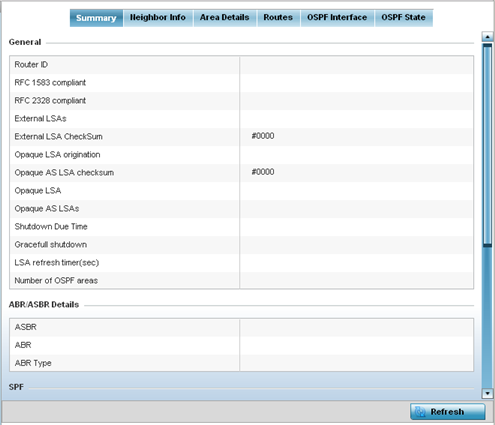AP OSPF Summary
Use the OSPF Summary screen to review router ID, area border router, shortest path and stub router connection assignments.
To view OSPF statistics:
- Select the Statistics menu from the Web UI.
- Expand the System node from the navigation pane (on the left-hand side of the screen). The System node expands to display the RF Domains created within the managed network.
- Expand an RF Domain node, select a controller or service platform, and select one of its connected access points. The access point's statistics menu displays in the right-hand side of the screen, with the Health tab selected by default.
- Expand the OSPF menu. The screen displays by default.
 The Summary screen describes the following information fields:
The Summary screen describes the following information fields:General The general field displays the router ID assigned for this OSPF connection, RFC compliance information and LSA data. OSPF version 2 was originally defined within RFC versions 1583 and 2328. The general field displays whether compliance to these RFCs have been satisfied. The OSPF LSA (Link-State Advertisement) Throttling feature provides a dynamic mechanism to slow down link-state advertisement updates in OSPF during times of network instability. It also allows faster OSPF convergence by providing LSA rate limiting in milliseconds. LSA information is provided for both external and opaque LSAs. Opaque LSAs carrying type-length-value elements. These extensions allow OSPF to run completely out of band of the data plane network. This means that it can also be used on non-IP networks, such as optical networks.
ABR/ASBR Lists ASBR (Autonomous System Boundary Router) data relevant to OSPF routing, including the ASBR, ABR and ABR type. An ABR (Area Border Router) is a router that connects one or more areas to the main backbone network. It is considered a member of all areas it is connected to. An ABR keeps multiple copies of the link-state database in memory, one for each area to which that router is connected An ASBR is a router connected to more than one Routing protocol and exchanges routing information with routers in other protocols. ASBRs typically also run an exterior routing protocol (for example, BGP), or use static routes, or both. An ASBR is used to distribute routes received from other, external ASs throughout its own autonomous system. Routers in other areas use ABR as next hop to access external addresses. Then the ABR forwards packets to the ASBR announcing the external addresses.
SPF Refer to the SPF field to assess the status of the SFF (shortest path forwarding) execution, last SPF execution, SPF delay, SPF due in, SPF hold multiplier,SPF hold time, SPF maximum hold time and SPF timer due flag.
Stub Router The summary screen displays information relating to stub router advertisements and shutdown and startup times. An OSPF stub router advertisement allows a new router into a network without immediately routing traffic through the new router and allows a graceful shut down or reload a router without dropping packets that are destined for other networks. This feature introduces three configuration options that allow you to configure a router that is running the OSPF protocol to advertise a maximum or infinite metric to all neighbors.
- Select Refresh to update the statistics counters to their latest values.



